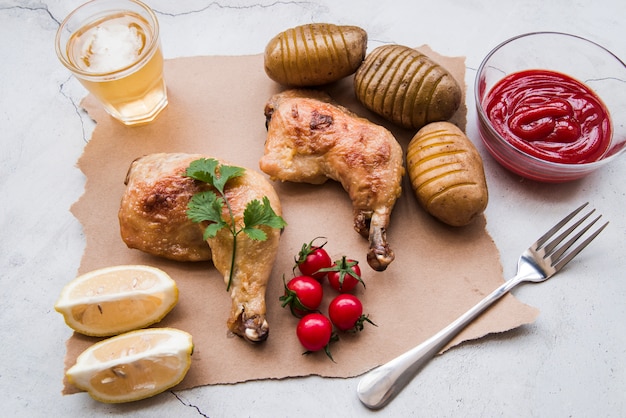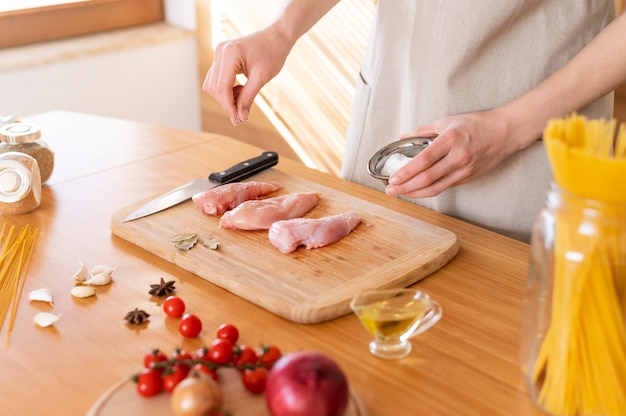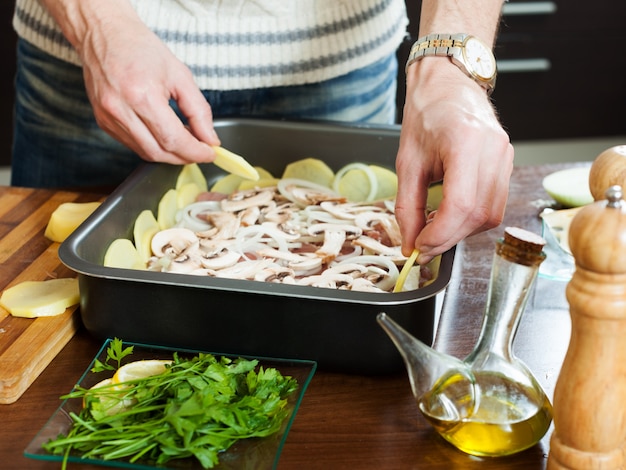Let's face it, cooking a bone-in turkey breast can feel a bit intimidating, especially if you're not a seasoned pro. But fear not! This comprehensive guide will lead you through each step, transforming you into a turkey-roasting maestro. I’ve learned countless tips and tricks along the way, some from trusty cookbooks, others from good old trial and error (and a few unfortunate turkey-related mishaps!). But hey, those are all part of the cooking journey, right?
You might be wondering why a bone-in turkey breast? It's not just about the deliciousness (which is undeniably a factor!), it's also about portion control. No need to cook a whole bird if you're just feeding a few. And let's not forget about that unparalleled bone-in flavor that simply can't be replicated with boneless breasts. Trust me on this one.
This guide will be your ultimate companion, from choosing the perfect bird to achieving a golden-brown crust and juicy, flavorful meat. We'll even explore delicious side dish ideas to make your Thanksgiving or Christmas feast truly spectacular.
(Part 1) The Turkey: Choosing Your Bird

The first step in this culinary adventure is selecting the perfect turkey breast. Just like choosing a good bottle of wine, you want to pick a bird that's going to deliver the best flavor and quality.
Head to your local butcher or supermarket and keep these key features in mind when choosing your bird:
Look for These Key Features:
- Freshness: First things first, always check the "use by" date and give the turkey breast a good look over. It should look nice and fresh, with no discoloration or drying.
- Fat Distribution: A good turkey breast will have a healthy layer of fat, crucial for keeping it juicy during cooking. Look for a balanced distribution, not just a big lump of fat in one spot.
- Size: Consider how many people you're serving. A 4-6 pound breast is perfect for a smaller gathering, while a larger bird might be needed for a bigger crowd.
- Bone-in or Bone-out: For that authentic bone-in flavor, choose a bone-in breast. Make sure the bone is intact and hasn't been cut through, otherwise, you might have some issues with the meat falling apart during cooking.
Choosing the Right Turkey Breast for You:
You've got a few options here, depending on your cooking style and preferences. Let's break down the choices:
- Fresh Turkey Breast: This is the most common choice and will give you the most flavorful results. Make sure to store it properly in the refrigerator until you're ready to cook.
- frozen turkey Breast: These come pre-brined or unbrined and are a great option if you need to plan ahead. Just remember to defrost it properly before cooking – give it plenty of time!
- Turkey Breast Thighs: For the ultimate juicy and flavorful turkey breast, consider getting one with the thigh attached. It might be a bit more work, but trust me, it's worth it!
(Part 2) The Brine: A Turkey's Best Friend

Now we're getting into the fun stuff – brining! Imagine it as a spa treatment for your turkey. Brining involves soaking the turkey in a salt water solution, which infuses the meat with moisture and flavor, creating a deliciously juicy and tender bird. I've tried both dry brining (rubbing with salt) and wet brining (soaking in a brine), and let me tell you, a wet brine is a game-changer. The results are simply phenomenal.
Here's why brining is a culinary secret weapon:
- Increased Moisture: Salt draws moisture out of the turkey and then draws it back in, resulting in an incredibly juicy bird.
- Enhanced Flavor: The salt and other ingredients in the brine add depth and complexity to the turkey's flavor, transforming it from ordinary to extraordinary.
- Tender Texture: Brining helps break down the muscle fibers in the turkey, resulting in a more tender and succulent roast.
How to Brine Your Turkey Breast:
Here's a simple, foolproof brine recipe that's a favorite in my kitchen:
Ingredients:
- 1 gallon of water
- 1 cup kosher salt
- 1/2 cup brown sugar
- 1 tablespoon black peppercorns
- 1 tablespoon dried thyme
- 1 tablespoon dried rosemary
Instructions:
- In a large pot or container, combine the water, salt, brown sugar, and spices. Stir until the salt and sugar dissolve.
- Place the turkey breast in a large plastic bag or container big enough to hold the bird and the brine.
- Pour the brine over the turkey breast, ensuring it's completely submerged.
- Refrigerate the turkey for at least 12 hours, preferably 24 hours.
- After brining, remove the turkey from the brine, pat it dry with paper towels, and discard the brine.
Important Tips:
- Don't overdo it: Brining for too long can make the turkey too salty. Stick to the recommended time.
- Complete submersion: Make sure the turkey is fully submerged in the brine.
- Refrigerate, refrigerate, refrigerate: Store the brined turkey in the refrigerator, not at room temperature.
(Part 3) Preparing Your Turkey Breast: Getting Ready to Roast

Now that your turkey breast is plump and happy from its brine soak, it's time to get it ready for its star turn in the oven. This is where we create those beautiful golden-brown crusts and juicy, flavorful meat. It's all about the prep!
Pre-Roasting Prep:
- Pat it dry: Remove your brined turkey breast from the fridge and pat it dry with paper towels. This step helps achieve a crispy skin.
- Season it up: Now's the time to add those extra flavor bombs. I like to use a simple blend of salt, pepper, and paprika. But feel free to get creative with your favorite herbs and spices – garlic powder, onion powder, thyme, rosemary, sage, the sky's the limit! Rub it all over the turkey, getting into those crevices for maximum flavor.
- Butter it up: Add a layer of butter or olive oil to the skin of the turkey. This helps it brown beautifully and prevents it from drying out. I find that a combination of both butter and olive oil really does the trick.
- Stuffing (Optional): If you're planning on stuffing your turkey breast, now's the time. Stuff it loosely with your favorite stuffing recipe, making sure to not pack it in too tightly.
- Roast it up: Find a roasting pan that's big enough to hold the turkey breast comfortably. I like to use a pan with a rack to help the heat circulate around the bird evenly. Don't forget to put a little bit of water in the bottom of the pan to create steam and prevent the turkey from drying out.
(Part 4) The Roast: Cooking Your Turkey Breast to Perfection
Alright, the big moment is here! Time to unleash the power of your oven and cook that turkey to perfection. It's a bit like a dance – you want to keep a close eye on things and make sure everything's moving along nicely.
The Roast:
- Preheat: Preheat your oven to 325 degrees Fahrenheit. A steady, moderate heat is key to cooking the turkey evenly and preventing it from drying out.
- Time is of the essence: A general rule of thumb is to cook a turkey breast at 325 degrees Fahrenheit for about 15-20 minutes per pound. However, it's always a good idea to check the internal temperature with a meat thermometer to ensure it's cooked through.
- Basting: I like to baste the turkey every 30-45 minutes with the pan juices. This helps keep it moist and gives it a lovely golden-brown skin. Be sure to carefully lift the turkey breast to avoid spilling the pan juices.
- The Resting Game: Once the turkey reaches an internal temperature of 165 degrees Fahrenheit for white meat and 170 degrees Fahrenheit for dark meat, it's time to let it rest. This allows the juices to redistribute, ensuring a juicy and flavorful turkey. Let the turkey rest, covered with foil, for at least 15-20 minutes before carving.
Temperature Guide for a Perfectly Roasted Turkey:
Here's a handy table for you:
| Part | Internal Temperature (°F) |
|---|---|
| White Meat | 165 |
| Dark Meat | 170 |
Troubleshooting:
Even the most seasoned cooks have their turkey-roasting moments. Here are some common issues and how to deal with them:
- Dry Turkey Breast: If your turkey breast is looking a bit dry, try adding a little more water to the roasting pan or basting it more frequently. You can also cover the turkey with foil for the last 30 minutes of cooking.
- Burnt Skin: If the skin is starting to burn, reduce the oven temperature slightly or cover the turkey with foil.
- Undercooked Turkey Breast: If the turkey breast isn't cooked through, pop it back in the oven for a few more minutes until it reaches the desired internal temperature.
(Part 5) The Carving: Bringing Your Turkey Breast to the Table
The big moment is finally here! Carving your turkey breast is like a culinary performance – it's all about precision and grace. But don't worry, it's not as complicated as it sounds.
Carving Tips:
- The Tools: You'll need a sharp carving knife and a carving fork. A carving board is also a good idea to catch any drippings.
- Start with the Breast: Place the turkey breast on the carving board and use the carving fork to hold it steady. Carefully slice the breast meat away from the bone, working in even slices. This will give you beautiful, evenly sized slices.
- Bone Removal: You can either remove the bone before slicing the breast or leave it in. If you want to remove it, simply follow the curve of the bone and cut along it to separate the breast meat from the bone. You can also carve around the bone to keep it intact and use it for stock later.
- The Thigh: If you're working with a turkey breast with the thigh attached, carve the thigh meat in a similar manner to the breast, slicing against the grain for the most tender pieces. Be sure to cut the thigh away from the bone.
- Serving Time: Arrange the carved turkey breast on a platter and serve it with your favorite side dishes.
(Part 6) Side Dish Symphony: Completing Your Turkey Feast
What's a turkey breast feast without a symphony of delicious side dishes to round it out? We're talking about creamy mashed potatoes, crispy roasted vegetables, and vibrant salads that dance on your palate. Here are some of my go-to side dish ideas that pair beautifully with a roasted turkey breast.
Classic Side Dish Harmony:
- Mashed Potatoes: Creamy, buttery, and comforting, mashed potatoes are a must-have for any turkey feast. I like to add a little bit of milk and butter for extra richness, and a touch of nutmeg for warmth.
- Roasted Vegetables: Bring on the color and crunch! Roasted vegetables are a perfect complement to the savory turkey breast. Think Brussels sprouts, carrots, asparagus, or even butternut squash. They're so easy to make and add a beautiful burst of flavor to your meal.
- Gravy: Oh, the gravy! A rich and flavorful gravy is the perfect way to tie everything together. Make it from scratch using the turkey pan drippings or use a store-bought gravy and just give it a little boost with a touch of your own flavor.
- Cranberry Sauce: This tart and tangy sauce is a classic holiday favorite. I love to make my own using fresh cranberries, sugar, orange juice, and a touch of cinnamon.
- Stuffing: Whether you prefer a traditional sage and onion stuffing or a more modern twist with wild mushrooms and cranberries, stuffing is a classic accompaniment to a roasted turkey. You can cook it separately or stuff the turkey breast, but be sure not to overstuff it to prevent the turkey from cooking evenly.
(Part 7) Leftover Love: Turning Leftovers into a New Feast
Leftover turkey breast? Don't even think about tossing it! It's a blank canvas for delicious new meals. With a little creativity, you can transform those leftovers into a culinary masterpiece.
Leftover Turkey Magic:
- turkey sandwiches: A classic for a reason. Pile slices of turkey on your favorite bread, add some lettuce, tomato, and mayonnaise, and you've got a satisfying lunch or light dinner.
- turkey soup: Turn your turkey leftovers into a hearty soup by simmering them in broth with vegetables like carrots, celery, and potatoes. Add a dollop of sour cream or a sprinkle of parsley for a finishing touch.
- turkey salad: Mix leftover turkey with mayonnaise, celery, onion, and your favorite seasonings for a tasty and refreshing salad. Serve it on bread, crackers, or lettuce.
- turkey pot pie: For a cozy meal, use leftover turkey in a pot pie. Mix the turkey with a creamy sauce and vegetables, then top it with a flaky crust. You can also use a store-bought crust to save time.
- Turkey Shepherd's Pie: For a heartier meal, use leftover turkey in a shepherd's pie. Layer a bed of mashed potatoes over a mixture of turkey, gravy, and vegetables for a comforting and satisfying dish.
- Turkey Enchiladas: For a Mexican-inspired twist, shred leftover turkey and use it to make enchiladas. Combine the shredded turkey with your favorite enchilada sauce, cheese, and vegetables, roll them up in tortillas, and bake until golden brown.
(Part 8) FAQs: Answering Your Turkey Breast Questions
You've got questions, I've got answers. Let's tackle those turkey breast mysteries.
1. Can I cook a turkey breast from frozen?
It's not recommended. While it's possible to cook a turkey breast from frozen, it's not the best way to achieve a juicy and flavorful result. The bird may cook unevenly, and the skin may be tough. It's always best to defrost the turkey breast completely before cooking it.
2. How do I know if my turkey breast is cooked?
The best way to check for doneness is to use a meat thermometer. The internal temperature of the turkey breast should reach 165 degrees Fahrenheit for white meat and 170 degrees Fahrenheit for dark meat. You can also check the turkey by inserting a fork into the thickest part of the breast. The juices should run clear.
3. What do I do if my turkey breast is dry?
It happens to the best of us! If your turkey breast is dry, you can try to add a little moisture back in by basting it more frequently or adding a little bit of broth or water to the roasting pan. You can also cover the turkey with foil for the last 30 minutes of cooking to help steam it.
4. How long does a turkey breast stay good in the fridge?
Cooked turkey breast can be stored in the refrigerator for 3-4 days. It's best to store it in an airtight container or wrapped tightly in plastic wrap.
5. Can I freeze leftover turkey breast?
Absolutely! To freeze leftover turkey breast, wrap it tightly in plastic wrap and then place it in a freezer-safe bag. Frozen turkey breast can last in the freezer for up to 2 months. When ready to use, thaw it in the refrigerator overnight.
There you have it, my friends! The ultimate guide to cooking a bone-in turkey breast to perfection. It might seem daunting at first, but with a little bit of preparation and a sprinkle of confidence, you can create a truly spectacular feast. So, get those ovens preheated, grab your favorite herbs and spices, and get ready to impress your family and friends with a turkey breast that will be the star of the show. Happy cooking!
Everyone is watching

How to Cook Frozen Lobster Tails Perfectly: A Step-by-Step Guide
RecipesLobster. Just the word conjures up images of lavish meals, special occasions, and a taste of luxury. But let's...

Pigs in a Blanket Cooking Time: How Long to Bake for Perfect Results
RecipesAh, pigs in a blanket. Just the name conjures up images of those delightful little parcels of crispy pastry en...

Pork Fillet Cooking Time: How Long to Cook It Perfectly
RecipesPork fillet, or tenderloin as it's sometimes called, is a real favourite in our house. It's so versatile, and...

The Ultimate Guide to Tender, Juicy Pulled Pork
RecipesRight, let's talk pulled pork. It's one of those dishes that just screams "comfort food," doesn't it? I mean...

The Ultimate Guide to Cooking Sweet Potatoes: From Roasting to Mashing
RecipesSweet potatoes. Just the name conjures up images of warm, comforting dishes, bursts of vibrant color, and a to...
